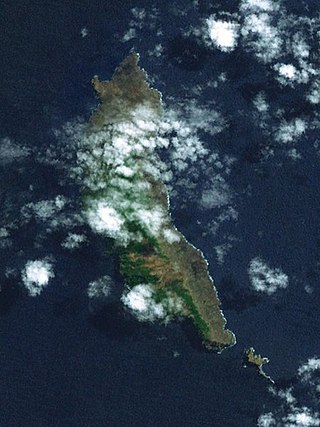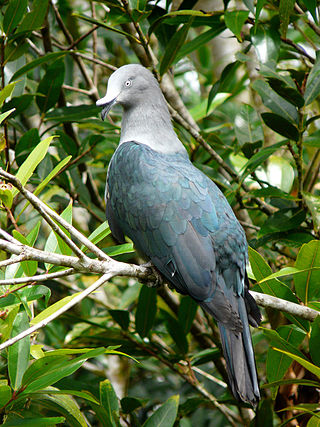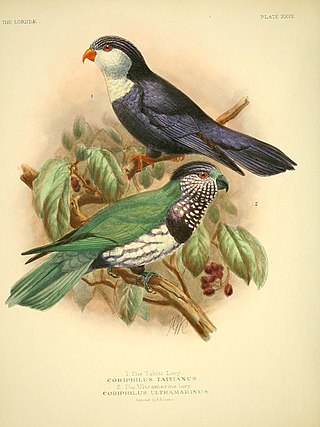
The monarchs comprise a family of over 100 passerine birds which includes shrikebills, paradise flycatchers, and magpie-larks.

Fatu-Hiva is the southernmost island of the Marquesas Islands in French Polynesia, an overseas territory of France in the Pacific Ocean. With Motu Nao as its closest neighbour, it is also the most isolated of the inhabited islands.

Mohotani is an uninhabited island southeast of Hiva Oa and east of Tahuata in the southern Marquesas Islands. It has an area of 15 km2. Much of the island's sparse vegetation has been destroyed by feral goats and sheep, to the extent that following its rare rains, the sea around it is stained red from runoff. Early reports describes the island as fertile, with forest and fields. When Thor Heyerdahl visited the island in 1938, there were only a few goats and remains of deserted huts and villages.

The Nuku Hiva imperial pigeon, also known as the Marquesan imperial pigeon or Upe, is a pigeon which is endemic to Nuku Hiva in the Marquesas Islands of French Polynesia. This pigeon is only found in some valleys in the western part of that island.

The ultramarine lorikeet is a species of parrot in the family Psittaculidae, endemic to the Marquesas Islands. Its natural habitats are subtropical or tropical moist lowland forest, subtropical or tropical moist montane forest and plantations. It is critically endangered, threatened mainly by introduction of the black rat and by deforestation.

The Rarotonga monarch, also known as the Rarotonga flycatcher or Kākerōri, is a species of bird in the monarch flycatcher family Monarchidae. It is endemic to Rarotonga, Cook Islands, and has been introduced to Atiu, Cook Islands.

Pomarea is a genus of birds in the monarch flycatcher family Monarchidae. The genus is restricted to the islands of Polynesia. The monarchs of this genus are around 15–19 cm long and most have sexually dimorphic plumage.
The Iphis monarch, or Ua Huka flycatcher, is a species of bird in the family Monarchidae. It is endemic to French Polynesia. Its natural habitats are subtropical or tropical dry forests, subtropical or tropical moist lowland forests, subtropical or tropical moist shrubland, and plantations.
The Marquesan monarch is a species of bird in the family Monarchidae. It is endemic to French Polynesia. Its natural habitats are subtropical or tropical dry forest, subtropical or tropical moist lowland forest, and subtropical or tropical moist montane forest. It is threatened by habitat loss.
The Ua Pou monarch is a species of bird in the family Monarchidae, endemic to the French Polynesian island of Ua Pou. Its natural habitats are subtropical or tropical moist lowland forest, subtropical or tropical moist montane forest, and heavily degraded former forest.

The Tahiti monarch, or Tahiti flycatcher, is a rare species of bird in the monarch flycatcher family. It is endemic to Tahiti in French Polynesia. There are between 25 and 100 individuals remaining with an increasing population trend. Adults boast a striking black plumage with pale blue pills and feet. Recognized for its melodious flute-like song and distinctive "tick-tick-tick" call, it thrives in dense forest, primarily inhabiting canopy and understory amidst native mara trees. Despite facing threats from introduces predators such as ship rats and invasive bird species, conservation efforts have been implemented to safeguard its population.
The Nuku Hiva monarch, or Nukuhiva flycatcher, was a species of bird in the family Monarchidae. It was endemic to French Polynesia. Its natural habitats were subtropical or tropical moist lowland forests, subtropical or tropical moist montane forests, and heavily degraded former forest. It became extinct due to habitat loss and introduced predators. The last confirmed sighting was in the 1930s and a possible sighting was reported in 1975.

The Maupiti monarch was a species of bird in the family Monarchidae. It was endemic to the island of Maupiti in the Society Islands. The Maupiti monarch became extinct shortly after the type specimen was collected in 1823 by the French Navy officer Jules de Blosseville. At the time of its collection, it was unknown to zoologists.
The Ornithological Society of Polynesia, also known as Manu, a Polynesian word for "bird", is an environmental non-governmental organization dedicated to the conservation of birds and their habitats in Polynesia. It was founded in July 1990 by bird enthusiasts in French Polynesia, for which it is the BirdLife International partner organisation. Its emblem is the red-tailed tropicbird.
Large flycatcher may refer to:

The Marquesas tropical moist forests is a tropical and subtropical moist broadleaf forests ecoregion in the Marquesas Islands of French Polynesia.









